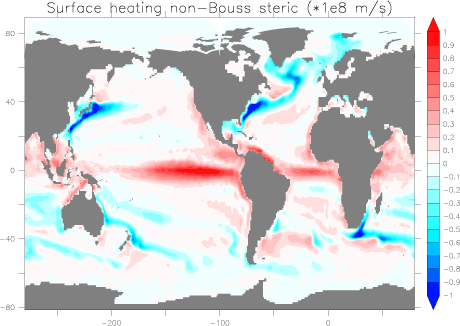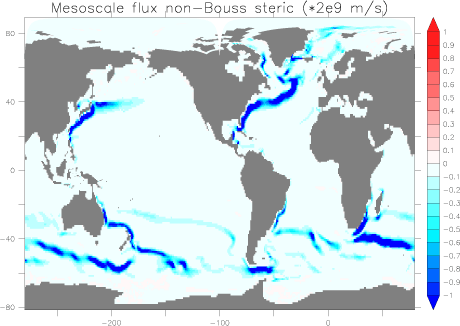June 8th, 2012
Key Findings
- Seawater expansivity due to heating is about ten times larger in the tropics than in the high latitudes, and it is larger in the upper ocean than the abyss. Hence, ocean heating in surface tropical waters raises sea level about ten times more than cooling in the high latitudes lowers sea level.
- Interior physical ocean processes associated with mixing and lateral eddy transport move heat from regions of large thermal expansion (tropics and surface) to smaller thermal expansion (high latitudes and abyss). In a steady state, there is a rough balance, so that the net sea level rise from surface heating is compensated by sea level drop due to mixing and eddy transport.
- Changes in the steady state, as may occur through global warming, lead to imbalances so that global mean sea level tends to rise through net thermal expansion.
S.M. Griffies and R.J. Greatbatch. Journal: Ocean Modelling. DOI: 10.1016/j.ocemod.2012.04.003
Summary
Global mean sea level reflects the combined effects of the total mass of seawater and its global mean density. Adding to the net seawater mass, as from melting land ice, raises sea level. Likewise, lowering seawater density, as when water is heated, raises sea level through so-called steric effects.
How much mass is added to or subtracted from the ocean largely involves issues related to land ice sheets and mountain glaciers. How ocean density is modified involves issues fundamental to physical oceanography, such as how heat (and to a lesser degree, salt) is transported across the ocean surface and within the ocean interior. This study focused on changes in density.
The net impact of heat on seawater density, and thus on sea level, is measured by the thermal expansion of seawater. The ability of seawater to expand is itself a function of temperature, salinity, and pressure. The thermal expansion of seawater varies by roughly a factor of ten across regions of the global ocean, thus strongly impacting the importance of ocean heating on changes to sea level. Furthermore, as heat crosses the ocean surface and moves through the ocean interior, it may move from regions where seawater more readily expands (i.e., regions of large thermal expansivity) to regions where it is less expansive.
Heat in the ocean tends to move from the tropics to the poles, in response to the net positive heating in the lower latitudes and cooling in the higher latitudes. Heat also moves from the warmer surface waters to abyss. This tendency for heat transfer corresponds to a movement of heat from regions of large thermal expansion to small thermal expansion. Consequently, surface ocean heating in the tropics, which raises sea level, is compensated by a drop in sea level as heat is transported both poleward and into the abyss.
Processes affecting this heat transport are associated with lateral eddy heat transport, ocean mixing, and cabbeling and thermobaricity. In effect, those physical processes in the ocean interior which affect heat transport create a net reduction in global mean sea level, and the net impact is to roughly balance the sea level rise from surface heating.
If the ocean were stagnant, with no turbulent mixing or eddy transport, sea level would rise much more through tropical heating than actually occurs in the real ocean, where mixing and lateral stirring processes move heat to regions of smaller thermal expansion.
This balanced situation occurs in an idealized state where all terms that may alter global mean sea level sum to zero. Global warming, in particular, changes this zero sum balance, thus causing a net sea level rise due to increases in surface warming. How the ocean interior physical processes respond to changes in surface warming remains a question for further research. The theoretical framework established in this study provides a conceptual and quantitative basis for such studies.




